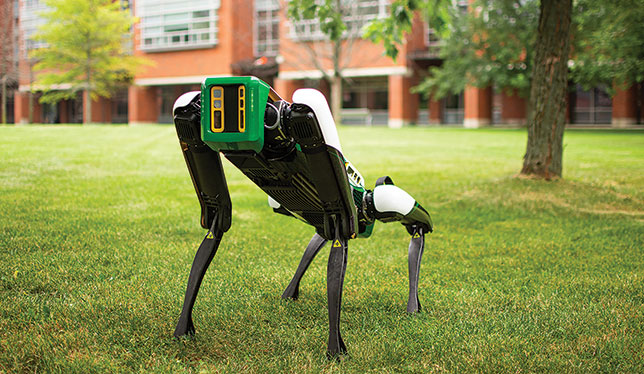With plans in motion to decommission Ontario Power Generation’s (OPG) nuclear power plant in Pickering, Ont. in the coming years, making sure that process is as safe as possible is of the utmost concern for the energy corporation, its employees, and the surrounding community. Nearby Ontario Tech University is working with OPG to test a four-legged solution that is part of an emergent field of engineering which could change how the maintenance of nuclear power plants is performed, and by whom.
Enter Spot, an “agile mobile robot” designed by U.S. design and engineering company Boston Dynamics. The company is infamous for its robots, which entered the public consciousness via viral videos dating back as early as 2004 with BigDog, Spot’s much larger predecessor. Spot represents the first publicly available iteration of this robotic technology, and for OPG’s Edward Lei, an opportunity to bolster the safety of the maintenance program at OPG.

“In any industry mistakes are made, but in our industry, a mistake can last a lifetime,” explained Mr. Lei. He takes a sombre tone as he recalls the three worst nuclear disasters: Three Mile Island (1979), Chernobyl (1986), and Fukushima (2011), events that had worldwide effects that are still being felt. “It’s with that level of seriousness that we must approach our work maintaining these nuclear plants.” As the nuclear maintenance programs manager, Mr. Lei is a part of a team of around 1,500 employees who work to maintain the structures, systems and components of both Pickering and Darlington nuclear power plants around the clock.
That maintenance doesn’t stop once a plant is decommissioned. “When we shut down a nuclear power plant it’s not as if someone just flicks a switch and that’s it,” explained Mr. Lei. “The facility still needs to be heated, and to be checked up on. Any burst pipes or wear and tear on the building is something we need to be aware of and address.” OPG’s plan for the plant’s decommissioning involves a period of a “safe storage state” between 2025 and 2028, before its fuel is removed for storage over the next 13 years. The facility won’t be fully dismantled until about 2065, according to OPG’s estimated timelines.
As a new technology, Spot’s capabilities in the field of industry are largely untested, so researchers are looking to understand its full potential prior to putting it to use doing field work. “It’s an exciting opportunity,” said Scott Nokleby, chair of the department of automotive and mechatronics engineering at Ontario Tech. “These Spot robots are at the forefront of a new wave of robotics, taking a step out of the research world and into more industrial applications.” Dr. Nokleby, the research lead on this project, is working alongside PhD student Christopher Baird, who will be testing the robot for his degree over the next three years.
Hey @Ontariotech_u! Meet SPOT, the @bostondynamics robot that just arrived to the OPG Engineering Building! He’s here for a 3 year research project within our @MARSlab, who has partnered up with @opg. Welcome to your new home! pic.twitter.com/KPl60noLNf
— Ontario Tech Engineering (@OT_FEAS) August 25, 2021
Dr. Nokleby described Spot as a mechatronic system, part of a burgeoning field of study that combines mechanical engineering, electrical engineering, software engineering, and control. “Spot is a perfect example,” he explained. Using Spot’s camera and artificial intelligence, Dr. Nokleby and Mr. Baird are testing Spot’s ability to see differences in gauges, valves and to notice overall changes in its environment – like a puddle or fire, all essential aspects of the maintenance work required daily at OPG. They’ve even tested its ability as a first response unit, equipping it with a fire extinguisher, which it successfully used to put out a diesel fire.
Spot’s been pulling double duty, dropping the puck at an Ontario Ridgebacks hockey game in November of last year. “It’s been good PR for the university,” Dr. Nokleby reflected. “We walk it around campus a lot, and I also talk about it in my grad class and in my undergrad robotics class. So they actually get to see that and what we’re doing with it.”
Next, Dr. Nokleby and the team at Ontario Tech are sending Spot back to Boston Dynamics to be fitted with an additional arm that will help it perform even more tasks, such as opening and closing doors, and pushing elevator buttons.
These findings have broad applications in industrial settings well outside of nuclear power, and so Ontario Tech is sharing its results with not only OPG, but Boston Dynamics as well, as a part of a user group across North America (including New Brunswick Power and Quebec Hydro) who are currently testing their own Spots. “I think [Boston Dynamic] is seeing that it makes sense to partner an industry partner with an academic institution like we have, because we can do this development offsite and then we can test it and then have it work in a real-world setting.”
For navigating complex terrain that could be challenging or dangerous for human employees, the employment of four-legged robots in particular offers a viable answer. It is crucial to make sure that these technical breakthroughs are applied appropriately and with regard for any possible ethical consequences.